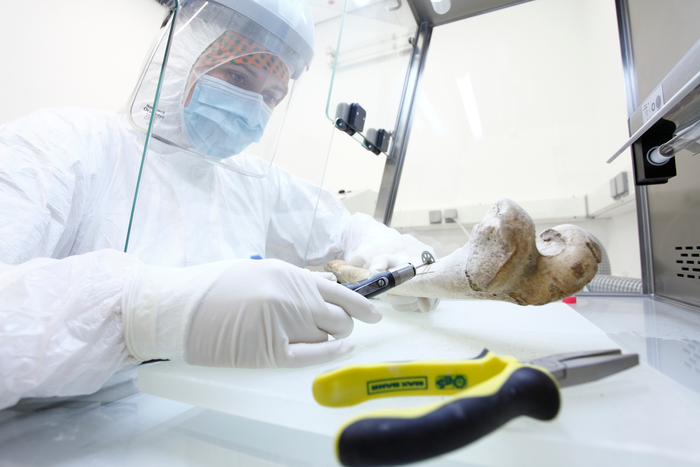Farming is assumed to have originated with a single population in Southwest Asia, which includes sections of today’s the Middle East, then spread to Turkey, Greece, and finally Western Europe.
 Researcher analyzing ancient human remains for paleogenetic research at Johannes Gutenberg University Mainz, Germany. Image Credit: Joachim Burger
Researcher analyzing ancient human remains for paleogenetic research at Johannes Gutenberg University Mainz, Germany. Image Credit: Joachim Burger
Researchers have long questioned how these groups arose and spread across these regions, but now an international research team has unearthed a range of new genetic data that may put the issue to rest.
Their findings, published in the journal Cell on May 12, demonstrate that the world’s first farmers resulted from the mixture of two groups of hunter-gatherers during a turbulent period when human settlements were on the verge of extinction.
I see the study as the first attempt at demonstrating demographic modeling based on ancient DNA.”
Laurent Excoffier, Study Senior Author and Population Geneticist, University Of Bern
The research team obtained higher-quality information and far more data than typical analyses based on deeper or partial sequencing by sequencing the genome of each ancient human numerous times, a process termed deep sequencing.
We get much more detail about the demographic history of those populations, including population divergence, expansions, and infer admixture dates, which lly impossible to do before.”
Laurent Excoffier, Study Senior Author and Population Geneticist, University Of Bern
A big initial population was divided into two groups about 25,000 years ago, according to the old DNA-based model, which was improved by extra geographical, cultural, archaeological, and climate information. One went to Western Europe and the other remained in Southwest Asia.
Later, as global temperatures dropped, the Western group’s population plummeted to the point that some species were on the verge of extinction. The concept explains why European hunter-gatherer ancestors have reduced genetic diversity, which has long perplexed experts.
This is a new finding, and it leads to a different interpretation of how these hunter-gatherer populations were structured socially.”
Laurent Excoffier, Study Senior Author and Population Geneticist, University Of Bern
Scientists previously assumed that the communities’ tiny population size was to blame for their lack of genetic variety, but fresh data suggests that their populations were far greater than previously assumed. “What it implies to us is that they were perhaps more connections between different groups,” Excoffier adds.
The population fluctuated as the temperature dropped and climbed. The populations spread during warm periods, leading to overlapping areas and admixtures, where people from formerly isolated groups interbred.
Around 12,900 years ago, an admixture of hunter-gatherers from a Western group and an already mixed group living in the east produced some of the earliest farmers, according to the scenario. Farmers who cultivated plants and animals then traveled west, spreading their culture to central Europe. Many individuals from all around Europe descend from them now.
The team then plans to look at ancient genomes from other places and times to learn more about the civilizations and populations that existed throughout the Stone Age and possibly the Bronze Age.
“While our study brought new results about history, I think what it shows is that it’s worth investing in high-quality genomic data,” says Excoffier. “These ancient materials are limited and too precious not to be optimally analyzed. We should extract as much information as possible, which will become lasting resources that could be shared.”
Source:
Journal reference:
Marchi, N., et al. (2022) The genomic origins of the world’s first farmers. Cell. doi.org/10.1016/j.cell.2022.04.008.